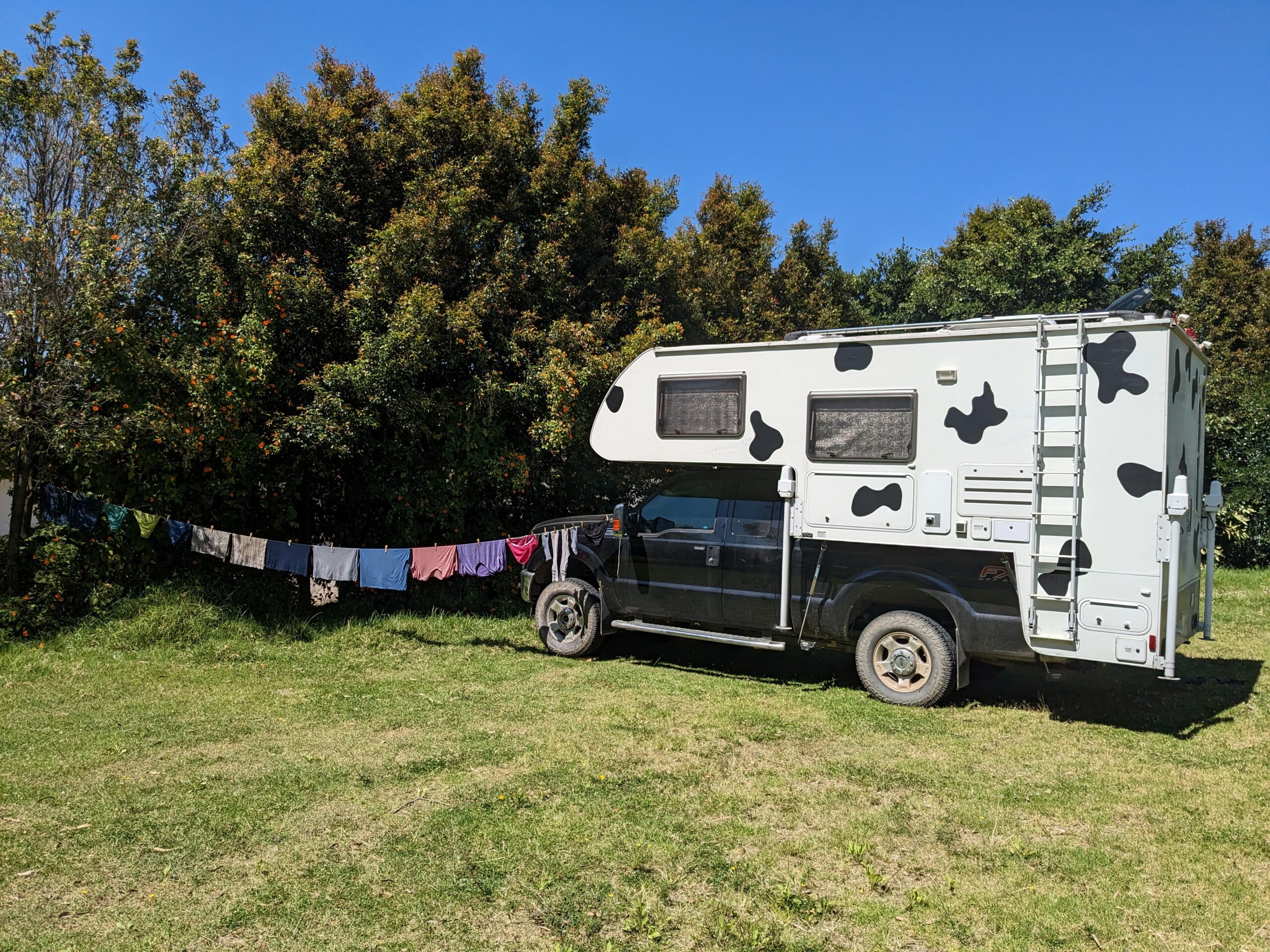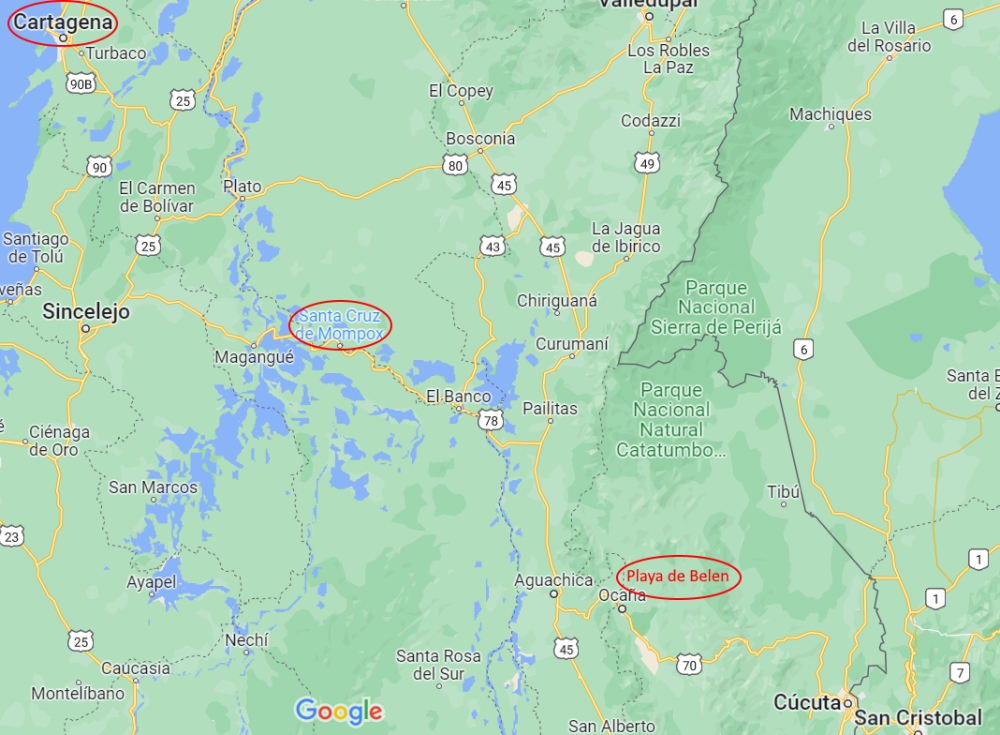
Every month, I post a report of our expenses to show that it is possible to live a comfortable, exciting, and adventurous life without breaking the bank. The less money you spend, the less you need to make. 🙂
This report includes ALL of our expenses, in US$, for two adults and one 60-pound dog (we adopted Maya on June 4th, 2019). Under groceries we incorporate food, produce, and non-alcoholic drinks predominantly bought in supermarkets. Toiletries belong in that category as well. Dining out means eating at a restaurant/event or purchasing take-out food. The health category covers non-prescription medicines and vitamins/supplements; medical contains prescription drugs and doctor’s visits. Because of our income level, Mark and I are eligible for free health care within the state of Massachusetts. For check-ups and extensive care, we return to the US East Coast.
In January, Mark, Maya, and I continued our Colombian overland explorations in Thirsty Bella, our truck camper disguised as a cow. As expected, we are spreading joy and smiles driving through villages and the countryside. And we are getting stuck in narrow town centers and battered by country roads a lot, too.
(As always, hover over or click on photos in galleries to read their captions.)

Driving through narrow Barichara

Driving through the mountains on small roads

Crossing a river in the mountains

One of the many narrow and rocky dirt roads we traversed in January

Bumpy road surface
Our grocery amount was decent and similar to the previous month. We are eating out regularly now, which might explain a drop in grocery costs and a jump in eating out. Life is much cheaper in Colombia than in the US, allowing us to splurge more. A decent dinner costs around $5-$8 a meal. It’s possible to eat cheaper and more expensive. Grocery shopping is affordable.

Lunch at a Belgian-run restaurant with Sheri and Jeff in Guane

Lunch out in Guane

Dinner out in Barichara

Small grocery store in Gambita

Crepe with fresh fruit and whipped cream

Saturday produce market in Villa de Leyva

Milhoja dessert at a bakery in Villa de Leyva

Splurge from a French bakery in Villa de Leyva

Fresh fruit and vegetables are easy to come by in Colombia!
While in the US and Canada we always camped for free, mostly in nature. Once we arrived in South America, it’s been a mix of boondocking in or on the edge of towns or along roads and paid campgrounds. That’s what the accommodation cost of almost $100 is attributed to.

Camped (for free) along the beautiful trail to Las Gachas

Parked for the night along the square in Gambita

Camped along the dirt road between Gambita and Palermo

Boondocked (free) along the lake in Paipa

Lago Sochacota in Paipa

Parked for the night (free) along the square of Tibasosa, the feijoa capital of the world

Maya poses in front of the town’s sign

Camped for a few nights (free) at higher elevation next to Laguna de Tota

Lake view through our window

Laguna de Tota

Another night of parking at the edge of a town, Mongui this time
On average, campsites cost $4 a person per day. Don’t expect hookups for that. We merely pay for a flat place to park in a safe environment. Sometimes, there are amenities like showers, toilets, and trash cans. Once in a while, a common space like a kitchen, firepit, or lounge and laundry facilities are available. Secure overnight parking in a lot is cheaper at around $2 a night.

Camped with our friends at an official campground in Barichara for a week over New Year

Sunset in the mountains

Communal kitchen at our campground in Barichara

Outdoor showers at Camping Guaimaro in Barichara

A paid camping spot in someone’s (overgrown) yard in Villanueva

Parked for the night at the hot springs. We did have to pay extra for that.

One (paid) night at a parking lot in Raquira
Our cost for internet was high last month. We paid $50 for our Google Fi plan, which allowed international roaming. Warned that this option was going to be suspended in February, we finally registered our phones in Colombia (mandatory by law) and bought local Claro SIM cards and data plans. The good news: internet is cheap in this country; the equivalent of $20 for 80GB of data (valid for one month). Propane is affordable and we use much less with our electric fridge. Most of the potable water we obtained (up to 48 gallons) was free.

Getting our phones registered in Duitama required fingerprints instead of signatures.

Getting our propane tank topped up. It was still half full after one month

Little chapel out of a propane tank

Filling up with potable cistern water at a gas station

Filling our tanks with potable water from the convent in Villa de Leyva
In February, we planned a visit to our friends Susan and John in El Retiro, near Medellin. They blog about their worldwide travels and Colombian expat life on Latitude Adjustment. This provided us with a shipping address – yes, Amazon ships certain items to Colombia! – so we ordered a few camper necessities, like a waterproof tarp, new propane hose, fridge thermostat, and water filters. Our alcohol expense was decent.
Last month, we also managed to apply for – and receive – visa extensions. If I would have entered the country with my Belgian passport, this would have been free for me. But I boasted my US citizenship when arriving, so I had to pay the same amount as Mark, around $23. Totally worth being able to spend another three months in Colombia, of course! Recently, we managed to get the same extension for Thirsty Bella from Customs (free). All of us can now legally stay in the country until May 8th.
In Villa de Leyva, while driving to a water spigot to top off our tanks, we passed through a narrow road, of which there are many in Colombia. It was a route we’d taken before, except, this time, a car was parked a distance from the curb. Instead of jumping out of the passenger seat like I usually do, I estimated we’d clear everything. When Mark rounded the parked car, we could hear roof tiles clatter onto the cobblestones. Darn…

We hit this overhang from a gate in Villa de Leyva

Pile of broken roof tiles on the ground
Our ladder had hit the decorative, overhanging tiles topping a cute gate. Luckily, the owners were relaxed about the scene and no harm was done to our camper. We gladly reimbursed the lady for eight broken tiles and the labor to fix the gate. Being in Colombia, paying for the damage didn’t set us back too much! That was the miscellaneous category.

Hiking in the mountains around Barichara

Hiking with our friends towards Guane

Hiking near Villanueva

The natural site of Las Gachas is free to visit, depending on which walking route you take.

Little known and free waterfall in Palermo

Maya meets a baby cow

Plaza Mayor in pretty Villa de Leyva

Strolling in the colorful town of Raquira

The colonial church and town square of Mongui

Maya in front of a historic bridge in Mongui
Besides hiking and exploring some natural sites and historic centers for free, we “splurged” on entertainment last month, visiting an interesting fossil museum in Villa de Leyva (El Fosil), hot springs in Iza (Piscina Erika), and a gorgeous waterfall near Gambita. Each destination was worth a stop or a strenuous hike!

The impressive top part of the waterfalls

Along the trail to the top of the waterfall

Piscina Erika hot springs

El Fosil museum

Depiction of the Monquirasaurus

El Fosil, a Kronosaurus that was renamed Monquirasaurus
The other categories were on the low end. Early January, I did laundry at a campground – three loads in three days, hanging everything to dry outside. The rest of the month, we washed by hand.

Camped for free on the edge of
Villa de Leyva and doing laundry by hand – the town offers free water
We took taxis a couple of times in skinny Barichara (“transportation”), I needed aspirin and more acetaminophen for my headaches, Maya could use more treats, we bought a gift for friends, and I finally received a professional haircut. The hairdresser took pride in her work and finished with 10 minutes of hair blowing. This unnecessary touch-up cost an extra 5,000 pesos ($1), totaling $6 for the entire experience. Oh, and Mark drank one beer out as well. At these prices, it is easy, fun, and possible for us to support local businesses!

Tuk tuk taxi in Barichara

Fresh haircut in Villa de Leyva!
We didn’t quite make it under $900, but we keep trying. Luckily, February only has 28 days. Our goal is to spend less than $800 a month in South America. We still have a way to go. Colombia is probably the cheapest country of the continent, so if we fail here, we might have to alter that target.


























































































